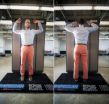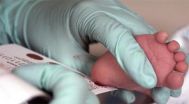(Press-News.org) A team of researchers from the University of California, San Diego, the University of Michigan, and Johns Hopkins University have discovered several security vulnerabilities in full-body backscatter X-ray scanners deployed to U.S. airports between 2009 and 2013.
In laboratory tests, the team was able to successfully conceal firearms and plastic explosive simulants from the Rapiscan Secure 1000 scanner. The team was also able to modify the scanner operating software so it presents an "all-clear" image to the operator even when contraband was detected. "Frankly, we were shocked by what we found," said J. Alex Halderman, a professor of computer science at the University of Michigan. "A clever attacker can smuggle contraband past the machines using surprisingly low-tech techniques."
The researchers attribute these shortcomings to the process by which the machines were designed and evaluated before their introduction at airports. "The system's designers seem to have assumed that attackers would not have access to a Secure 1000 to test and refine their attacks," said Hovav Shacham, a professor of computer science at UC San Diego. However, the researchers were able to purchase a government-surplus machine found on eBay and subject it to laboratory testing.
Many physical security systems that protect critical infrastructure are evaluated in secret, without input from the public or independent experts, the researchers said. In the case of the Secure 1000, that secrecy did not produce a system that can resist attackers who study and adapt to new security measures. "Secret testing should be replaced or augmented by rigorous, public, independent testing of the sort common in computer security," said Prof. Shacham.
Secure 1000 scanners were removed from airports in 2013 due to privacy concerns, and are now being repurposed to jails, courthouses, and other government facilities. The researchers have suggested changes to screening procedures that can reduce, but not eliminate, the scanners' blind spots. However, "any screening process that uses these machines has to take into account their limitations," said Prof. Shacham.
INFORMATION:
The researchers shared their findings with the Department of Homeland Security and Rapiscan, the scanner's manufacturer, in May. The team will present their findings publicly at the USENIX Security conference, Thursday Aug. 21, in San Diego. Details of the results will be available at https://radsec.org/ on Aug. 20.
To contact the research team, e-mail radsec-team@umich.edu.
Researchers find security flaws in backscatter X-ray scanners
2014-08-20
ELSE PRESS RELEASES FROM THIS DATE:
Testing the shelf-life of nuclear reactors
2014-08-20
Oxford, August 20, 2014 – Researchers at the University of Michigan, Ann Arbor, Los Alamos National Laboratory, Idaho National Laboratory, Idaho Falls and TerraPower based in Bellevue, Washington, have demonstrated the power of high-energy beams of charged particles (ions). The ions can rapidly and consistently damage samples of ferritic-martensitic steel, the material used in certain nuclear reactor components. The significance of the result is that the breakdown closely replicates that seen when high-energy neutrons from a nuclear reactor interact with the material - ...
Chemically extracted acellular allogeneic nerve graft with CNTF for sciatic nerve repair
2014-08-20
Chemically extracted acellular allogeneic nerve, from which Schwann cells, myelin sheath and disintegrating fragments have been removed, reduced postoperative immune rejection. Simultaneously, chemically extracted acellular allogeneic nerve retains neural substrates and base materials, such as the bottom layer of Schwann cells, which can provide a good scaffold in the process of nerve regeneration. Chemically extracted acellular allogeneic nerve, similar to autologous nerve transplantation, can guide nerve regeneration and provide a favorable local environment for neural ...
The channel that relaxes DNA
2014-08-20
VIDEO:
This is a model DNA chain inside a nanochannel that is 100nm wide.
The spontaneous dynamical evolution of the DNA is accompanied by frequent knotting and entanglement at the chain ends....
Click here for more information.
With the widespread use of methods for DNA analysis and manipulation, it's certainly useful to find a way to unravel and relax the strands of this molecule that tends to form tangles spontaneously. One way is to use channels, or rather nano-channels, ...
Test reliably detects inherited immune deficiency in newborns
2014-08-20
A newborn screening test for severe combined immunodeficiency (SCID) reliably identifies infants with this life-threatening inherited condition, leading to prompt treatment and high survival rates, according to a study supported by the National Institutes of Health. Researchers led by Jennifer Puck, M.D., of the University of California, San Francisco, also found that SCID affects approximately 1 in 58,000 newborns, indicating that the disorder is less rare than previously thought. The study was funded in part by NIH's National Institute of Allergy and Infectious Diseases ...
Mums trust mums on the net: Australian study
2014-08-20
Facebook groups for mothers are overtaking the traditional mums-and-bubs and playgroup environments as a source of trusted advice, and offers a largely untapped marketing tool for businesses wanting to sell their products, an Australian study has found.
QUT educationalist Dr Rebecca English and marketing expert Dr Raechel Johns from the University of Canberra said word-of-mouth in mothers' groups and communities had fast become a major influence in mothers' buying habits.
The study, Mothers' influencing mothers: the use of virtual discussion boards and their influence ...
Sunblock poses potential hazard to sea life
2014-08-20
The sweet and salty aroma of sunscreen and seawater signals a relaxing trip to the shore. But scientists are now reporting that the idyllic beach vacation comes with an environmental hitch. When certain sunblock ingredients wash off skin and into the sea, they can become toxic to some of the ocean's tiniest inhabitants, which are the main course for many other marine animals. Their study appears in the ACS journal Environmental Science & Technology.
Antonio Tovar-Sanchez and David Sánchez-Quiles point out that other than staying indoors, slathering on sunscreen is currently ...
Diabetes calculator helps identify A&E patients at risk of disease
2014-08-20
A new online tool will help doctors predict which patients are most likely to develop diabetes.
The calculator will help doctors identify high risk patients so that they can be tested for the disease and offered lifestyle advice. The test is targeted at people who have been admitted to hospital for emergency care.
Experts say it could offer a cost-effective way to identify people with diabetes in Scotland as it avoids the need for significant investment in screening.
The test calculates a person's risk of developing diabetes over the next three years based on their ...
Seeing a molecule breathe
2014-08-20
For the first time, chemists have succeeded in measuring vibrational motion of a single molecule with a femtosecond time resolution. The study reveals how vibration of a single molecule differs from the behaviour of larger molecular groups.
The study was performed at the University of California, Irvine, where post-doctoral researcher Eero Hulkko from the University of Jyväskylä works as a visiting fellow under professor Vartkess A. Apkarian, whose team participated in the study. The second team was lead by Professor Eric O. Potma. The results of the study made the cover ...
Treating pain by blocking the 'chili-pepper receptor'
2014-08-20
Biting into a chili pepper causes a burning spiciness that is irresistible to some, but intolerable to others. Scientists exploring the chili pepper's effect are using their findings to develop a new drug candidate for many kinds of pain, which can be caused by inflammation or other problems. They reported their progress on the compound, which is being tested in clinical trials, in ACS' Journal of Medicinal Chemistry.
Laykea Tafesse and colleagues explain that decades ago, scientists had pegged a compound called capsaicin as the active ingredient in chili peppers that ...
USC Eye Institute study finds African-Americans at higher risk for diabetic vision loss
2014-08-20
LOS ANGELES — Research by Keck Medicine of USC ophthalmology scientists demonstrates that African Americans bear heavier burden of diabetic macular edema (DME), one of the leading causes of blindness in diabetic patients in the United States.
The research published online today in the Journal of the American Medical Association (JAMA) Ophthalmology, indicates a higher burden of diabetes-related vision loss among certain ethnic populations because of problems with access to care, said corresponding author Rohit Varma, M.D., M.P.H., director of the USC Eye Institute and ...




